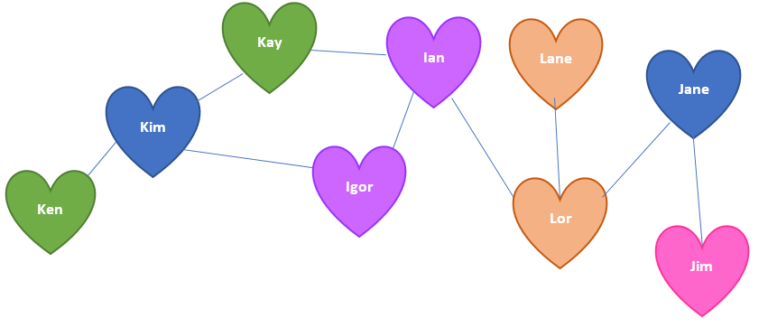How to Navigate Polyamory Single
Exploring Polyamory in Singlehood
Polyamory, the practice of engaging in multiple romantic relationships with the consent of all parties involved, is a relationship model that challenges traditional societal norms. For many, the concept of polyamory may seem out of reach or only applicable in the context of being in a committed partnership. However, it is entirely possible to explore and embrace polyamory while being single. In fact, singlehood can provide a unique opportunity to explore different types of relationships and connections without the constraints of a primary partnership. This article will explore how individuals can navigate the world of polyamory while being single, including communication strategies, potential benefits and challenges, and the importance of self-awareness and self-care in this journey. Whether it involves dating multiple people simultaneously or engaging in non-monogamous relationships, understanding and embracing polyamory in singlehood can be a fulfilling and eye-opening experience.
Dispelling Myths
Polyamory is often misunderstood as simply the act of being involved with multiple partners at the same time. However, this is a misconception that needs to be addressed. Polyamory is not solely about having multiple partners, but rather, it is about embracing a mindset and approach to relationships that prioritize open communication, honesty, and consent.
Emphasizing the number of partners in a polyamorous relationship ignores the key principles that define it. Polyamory is about forming deep, meaningful connections with others based on mutual respect and understanding. It is not about simply juggling multiple romantic or sexual relationships without regard for the feelings and well-being of those involved.
By dispelling the myth that polyamory is solely about having multiple partners, we can encourage a more nuanced understanding of what it truly means to be polyamorous. It is about embracing love and connection in a way that is not limited by societal norms or expectations. It is about creating relationships that are based on trust, communication, and respect, regardless of the number of partners involved.
In conclusion, polyamory is not just about the number of partners one has, but rather the mindset and approach to relationships that prioritize mutual understanding, consent, and respect. It is important to address this misconception and promote a more accurate understanding of what it means to be polyamorous.
Personal Growth and Exploration
Being single provides numerous opportunities for self-discovery. Without the constraints of a romantic relationship, individuals have the freedom to explore their own interests, hobbies, and passions. They can dedicate time to self-reflection, understanding their own desires and boundaries, and working on personal growth. Being single allows individuals to focus on their own needs and priorities, leading to a better understanding of themselves and what they want out of life.
Understanding personal desires and boundaries is crucial before entering polyamorous relationships. It is important for individuals to have a clear understanding of their own needs, what they are comfortable with, and what they are looking for in a relationship. This self-awareness can help individuals navigate the complexities of polyamory and communicate effectively with their partners. Without a solid understanding of personal desires and boundaries, individuals may find themselves in situations that are emotionally or mentally challenging.
In conclusion, being single provides the space for personal growth and exploration, allowing individuals to gain a deeper understanding of themselves. This self-awareness is essential for navigating polyamorous relationships and ensuring that individuals are able to communicate their needs and boundaries effectively. By taking the time to understand themselves, individuals can enter into relationships with a stronger sense of self and a clearer understanding of what they want and need.
Building a Polyamorous Mindset
Building a polyamorous mindset involves shifting away from traditional ideas of monogamy and embracing the concept of having multiple loving and meaningful relationships. It requires open communication, honesty, and a willingness to challenge societal norms and beliefs about love and commitment. This mindset encourages individuals to approach relationships with a sense of abundance rather than scarcity, and to prioritize personal growth and self-awareness. Building a polyamorous mindset involves exploring and understanding one’s own desires, boundaries, and needs, while also respecting the autonomy and agency of others. It challenges individuals to let go of jealousy and possessiveness, and to instead foster trust, compersion, and mutual support within all of their connections. Ultimately, building a polyamorous mindset involves cultivating a deep sense of empathy, compassion, and respect for the diverse ways in which people experience and express love and intimacy.
Open Communication
Communication plays a crucial role in polyamorous relationships, as well as in any other type of relationship status. In polyamorous relationships, the need for open and honest communication is often amplified due to the multiple individuals involved. It is essential for all partners to openly express their needs, desires, boundaries, and concerns in order to maintain a healthy and respectful dynamic. Without effective communication, misunderstandings, jealousy, and conflicts can arise, potentially leading to the deterioration of the relationships.
In any type of relationship, open and honest communication brings numerous benefits. It fosters trust, understanding, and emotional intimacy between the partners. It allows individuals to express themselves authentically, leading to a greater sense of connection and satisfaction. Moreover, when partners communicate openly, they can work through challenges and conflicts more effectively, ultimately strengthening the relationship.
Overall, communication is the cornerstone of any successful and fulfilling relationship, whether it is monogamous, polyamorous, or any other configuration. By prioritizing open and honest communication, partners can cultivate a strong foundation based on mutual respect, understanding, and love.
Embracing Non-Traditional Relationship Structures
Embracing non-traditional relationship structures involves exploring different forms of non-monogamous relationships. This can include open relationships, polyamory, swinging, or relationship anarchy. It’s important to understand that non-monogamous relationships come in various forms and each dynamic may look different from the next.
Polyamory, for example, encompasses a wide spectrum of possibilities, from hierarchical to non-hierarchical relationships. Some polyamorous relationships involve primary and secondary partners, while others operate with an egalitarian approach where all partners are considered equal. Communication, honesty, and consent are key components in navigating these dynamics.
Non-traditional relationship structures challenge societal norms and promote individual autonomy in choosing the relationship style that best fits the people involved. It’s about fostering a sense of freedom, trust, and respect among all partners, and embracing the idea that love and intimacy are not limited resources.
Discussing the spectrum of polyamorous possibilities and relationship dynamics is essential in understanding the diverse ways in which non-monogamous relationships can thrive. By recognizing and respecting the different forms of non-traditional relationships, we can promote a more inclusive and understanding society for all types of love and partnerships.
Challenges and Considerations
When facing any new project or decision, it’s important to carefully consider the potential challenges and important factors that will impact the outcome. Whether it’s a personal goal, a business plan, or a community initiative, understanding the challenges and considerations involved can help to foresee obstacles and plan for success. In this section, we will explore common challenges that may arise in various situations, and important considerations to keep in mind when navigating through them. By understanding both the hurdles and the necessary considerations, we can better anticipate and address any obstacles that may come our way, and ultimately achieve our desired outcomes. Let’s delve into the potential challenges and vital considerations that can impact the success of our endeavors.
Navigating Jealousy
In polyamorous relationships, navigating jealousy can be a common challenge. It’s important to address this issue openly and honestly within the relationship. Communication is key in managing jealousy, as it allows partners to express their feelings and insecurities. Setting boundaries and expectations can also help to alleviate jealousy, as it provides a sense of security and predictability within the relationship.
Developing strategies to manage and overcome feelings of jealousy is essential. This may include practicing self-awareness and introspection to understand the root causes of jealousy. Building self-confidence and self-esteem can also help to combat feelings of insecurity. Additionally, focusing on building trust and fostering a strong emotional connection with partners can help to reduce jealousy in polyamorous relationships.
It’s important for partners to work together to create a supportive and nurturing environment that promotes understanding and empathy. Seeking outside support, such as therapy or counseling, can also be beneficial in addressing and working through feelings of jealousy.
By addressing common challenges related to jealousy and implementing strategies for managing and overcoming these feelings, polyamorous individuals can create healthy and fulfilling relationships.
Time Management
in Polyamorous Relationships
Time management is crucial in polyamorous relationships as it involves balancing multiple connections and commitments. With multiple partners, it’s essential to allocate time and attention to each relationship in order to maintain harmony and ensure that each individual feels valued and prioritized.
To effectively manage time in polyamorous relationships, communication is key. It’s essential to have open and honest discussions with all partners to establish schedules, boundaries, and expectations. This will help in avoiding misunderstandings and resentment, as well as ensure that everyone’s needs are being met.
In order to balance multiple connections and commitments, it’s important to prioritize and organize tasks efficiently. Setting aside specific time for each partner and committing to being fully present during those times can help in strengthening each relationship and maintaining a sense of connection.
Additionally, practicing self-care and setting aside personal time is equally important in polyamorous relationships. Taking care of one’s own needs and well-being is essential in order to be fully present and available for multiple partners.
In conclusion, time management is crucial in polyamorous relationships to ensure that each partner feels valued and respected. By effectively managing time, communicating openly, and practicing self-care, individuals in polyamorous relationships can create a healthy and fulfilling dynamic with their multiple partners.
Polyamory and Singlehood: Finding Compatibility
Finding compatibility in relationships is a universal pursuit, regardless of the type of relationship one seeks. For those exploring polyamory, the practice of engaging in multiple intimate relationships with the full knowledge and consent of all involved, compatibility takes on new dimensions. Similarly, for individuals embracing singlehood as a way of life, finding compatibility becomes a quest for personal alignment and fulfillment. In this article, we will explore the concept of compatibility within the context of polyamory and singlehood, and examine how individuals in these relationship dynamics can navigate the intricate terrain of emotional, physical, and personal compatibility.
Seeking Like-minded Individuals
If you are interested in polyamory, there are several communities and platforms available to connect with like-minded individuals. Websites and forums like PolyMatchMaker, OpenMinded, and BeyondTwo provide a space for people to explore and discuss polyamorous relationships. These platforms also offer resources, support, and advice from experienced individuals who are familiar with the polyamorous lifestyle.
When navigating the dating and social scenes with a polyamorous mindset, it’s important to be open and honest about your intentions and boundaries. Communication is key in any relationship, but especially in polyamorous ones where multiple partners are involved. It’s also important to educate yourself about ethical non-monogamy and understand the difference between polyamory and other forms of non-monogamous relationships.
Additionally, seeking out local meetups, events, and discussion groups can provide opportunities to connect with others who share similar values and beliefs about polyamory. These gatherings can offer a sense of community and support, as well as the chance to learn and grow within the polyamorous lifestyle.
Overall, seeking like-minded individuals in the polyamorous community involves being proactive, open-minded, and respectful of others’ boundaries and beliefs. By exploring different platforms and engaging with local communities, you can find the support and connections you need to navigate the polyamorous lifestyle.
Establishing Boundaries
Setting and respecting boundaries is crucial in any type of relationship, including polyamorous ones. It is important to establish and communicate boundaries clearly and openly to ensure that everyone involved feels respected and understood. In a polyamorous dynamic, where multiple relationships are occurring simultaneously, the need for boundaries becomes even more paramount.
Emphasizing the significance of setting and respecting boundaries in a polyamorous relationship is key to ensuring that all partners feel valued and secure. This may involve discussing expectations, defining what is and isn’t acceptable behavior, and establishing guidelines for communication and time management. By doing so, individuals can feel more confident in their relationships and avoid potential misunderstandings or conflicts.
Clear communication of boundaries can also enhance single polyamorous experiences by creating a sense of trust and understanding among all partners. When each person’s needs and limits are clearly expressed and respected, it can lead to a more harmonious and fulfilling dynamic.
In conclusion, prioritizing the setting and respecting of boundaries in polyamorous relationships is essential for creating a healthy and respectful environment. By openly discussing and establishing boundaries, individuals can foster stronger connections and ensure that everyone’s needs and feelings are taken into consideration.
Solo Voyages in Love’s Vast Sea: Charting Your Polyamorous Journey
Embark on a singular adventure through the realms of polyamory, discovering the joy and depth of connections as a solo navigator. SwingTowns welcomes you to a community where individual paths converge in a celebration of love’s diversity and potential. Start your unique exploration by signing up for a free account on SwingTowns today, and unlock the door to a world where being single opens endless opportunities for companionship, growth, and love. Together, let’s set sail into a future where every relationship is an adventure waiting to be discovered.
“Swingtowns.com has been one of the best places for meeting like minded and fun party people. I’m always looking to meet new people and this site never fails.” -PoundnSand
Also Read: Polyamory and Sexual Exploration







